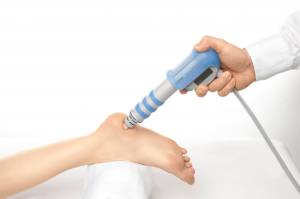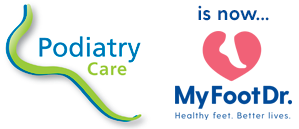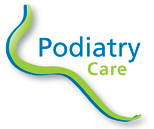 During Radial Extracorporeal Shock Wave Therapy, a high-intensity sound wave is transmitted from a probe through the skin where it interacts with the tissues of the body. This leads to a cascade of beneficial effects such as increased blood flow and metabolic activity to the area, reversal of chronic inflammation, stimulation of collagen and dissolution of calcium build-up. Stimulation of these biological mechanisms creates an optimal healing environment. As the injured area is returned to normal, functionality is restored and pain is relieved. (see below)
During Radial Extracorporeal Shock Wave Therapy, a high-intensity sound wave is transmitted from a probe through the skin where it interacts with the tissues of the body. This leads to a cascade of beneficial effects such as increased blood flow and metabolic activity to the area, reversal of chronic inflammation, stimulation of collagen and dissolution of calcium build-up. Stimulation of these biological mechanisms creates an optimal healing environment. As the injured area is returned to normal, functionality is restored and pain is relieved. (see below)
This form of treatment was developed from other medical indications such as treating kidney stones and is widely used in Europe and North America for treatment soft tissue conditions such as Plantar Fasciitis and Achillis Tendonitis. There are numerous published scientific studies, which you are free to request, the majority of which demonstrate positive outcomes. Most importantly it has been demonstrated as a safe treatment option.
Clinical studies report success rate above 75%
The Beneficial Effects Of Extracorporeal Shock Wave Therapy Are Widely Known.
Scientists Recognize That Shock Waves Can Trigger a Variety of Effective Actions …
INHIBITS SUBSTANCE P One of the bodies messenger substances is substance P, a pain mediator and growth factor. On the one hand, the inhibition of the release of substance P by shockwaves has an analgesic effect. Its secondary effect is to dilate the blood vessels and stimulate blood circulation as well as contributing to the formation of new bone tissue. “NO” (nitric oxide) also has a vasodilatory effect and plays an important role in angiogenesis (Formation of new blood vessels)
“In short, when applied where pain occurs, we know why shockwaves produce an analgesic effect, increase blood circulation and to facilitate the repair process”.
INHIBITS THE COX II ENZYME By inhibiting inflammatory mediators such as COX II, shockwaves produce an anti-inflammatory effect. This weakens any inflammatory process.
ACTIVATES CELLULAR DEFENSES By contributing to the release of free radicals, shockwaves help strengthen the body’s endogenous cellular defense mechanisms to protect it from disease.
HYPERSTIMULATES NERVE FIBRES Scientific studies also show that shockwaves act in another way. Overstimulating the nerve fibres blocks an increase in pain stimuli and therefore intensifies the analgesic effect (Gate Control Theory)
As well as …
- Metabolism is increased at the application site
- Irritating calcium deposits in and around tendons areresorbed
- Fibres are separated to allow for more efficient blood flow and Range of Motion.
- Inflammatory activity and its consequences are reduced
- Tenderness is reduced
- Mechanical loading is increased
About the treatment
After a simple examination of the affected area, shock waves are applied via a hand piece or applicator held against the skin. The initial phase of treatment may cause some deep pain however this indicates correct targeting of the problem area.
This is usually followed by numbness or heaviness in the area and the latter phase of the treatment feels less painful. The treatment sessions are of 10 minutes duration during which you may receive up to 2000 pulses. Many patients get pain relief in just 8-10 days after the first treatment. Depending on the condition and your response you may require from 2 to 5 treatments, although the average is 3.
After the treatment
You may feel some soreness which can intensify on the night of treatment. Simple pain relief and icing may be required to control this pain. There may also be some minor bruising in the treatment area. You should rest from aggravating activities for 2-3 days after treatment as your Podiatrist will discuss.
Side Effects
Post-treatment pain as above.
Local bruising – uncommon and minor.
Contraindications
Please inform your doctor if you have a one of the following contra-indications as this form of treatment may not be appropriate for you –
- Pregnancy
- Bleeding and blood coagulation disorders and associated medication consumption.
- Skin wound or acute inflammation in treatment area.
- Tumour in treatment area.
One treatment … Many applications
1. EPICONDYLITIS HUMERI RADIALIS
Painful inflammation of the tendon attachment on the medial elbow
2 .TENDINOSIS CALCAREA
Painful limitation of shoulder movement due to calcification
3. EPICONDYLITIS HUMERI ULNARIS
Painful inflammation of the tendon attachment on the lateral elbow (golfer’s elbow)
4 .BURSITIS TROCHANTERICA
Painful periostitis of the outer femur
5. PATELLA TIP SYNDROME
Inflammation of the point of attachment of the patellar ligament
6. TIBIALIS ANTERIOR SYNDROME
Inflammation of the tibial edge due to excessive strain
7. ACHILLODYNIA
Painful irritation of the Achilles tendon
8. FASCIITIS PLANTARIS
Painful, mostly chronic inflammation of the plantar fascia
9.CHRONIC ENTHESOPATHIES
Painful irritation of tendon attachments due to overexertion or improper strain, or due to degenerative processes
10.ACUPUNCTURE POINTS
Pain therapy via treatment of acupuncture points
11.PAINFUL TRIGGER POINTS
Acute and chronic pain in the back, shoulder, neck, etc. due to permanently shortened and thickened muscles
STUDIES / PUBLICATIONS (complete list of PAPERS AT ismst.com)
There are more than 100 treatment reports and clinical studies about the treatment with the EMS Swiss DolorClast® available. The following selection of studies were published in acknowledged scientific journals Treating Plantar Fasciitis.
- Dr. H. Lohrer, Achillodynia and patellar tendinitis – results of the treatment of chronic cases with radial shockwaves. Journal “Sportverletzung, Sportschaden” No. 16, October 2002.
- Dr. P. Magosch, ATOS Clinic Heidelberg (Germany). Radial Shockwave Therapy in Calcific Tendinitis of the Rotator Cuff. 2003
- Prof. Dr. Rompe, OrthoTrauma Clinic, Grünstadt. Achillodynia – Results of a comparison study! Orthopädie Report, October 2006.
- Dr. L. Gerdesmeyer / Dr. L. Scott Weil et al. Summary of Clinical Study Results / FDA – PMA Approval,
- Treatment of painful heel, May 2007
SCIENTIFIC BOOK PUBLICATIONS
- Dr. Maier / Gillesberger, Abstractbook, Shockwave foundations 2003, ISBN 3-8330-0423-1
- Dr. L. Gerdesmeyer, ExtrakorporaleStosswellentherapie, 2004, ISBN 3-8334-1088-4
- Dr. Herisson, Ondes de choc extra-corporelles en médicieorthopédique, 2004, ISBN 2-84023-365-7
- Dr. L. Gerdesmeyer / Dr. L. Scott Weil, Extracorporeal Shockwave Therapy, 2007, ISBN 978-1-57400-115-0
Treatment of Painful Heel (May 2007)
L.Gerdesmeyer, L. Weil Sr., M. Maier, H.Lohrer, C. Frey, K.Feder, J.Stienstra,M.Russlies, K.Neitzel, M. Schmitt-Sody, B.Scurran
Conclusion
The results of the clinical study provide reasonable assurance that the EMS Swiss DolorClast® is safe and effective when used in accordance with the device labeling. The results of the multi-center, randomized, placebo-controlled, double-blinded clinical study demonstrate that treatment with the EMS Swiss DolorClast® provides significant pain relief to patients with symptoms of proximal plantar fasciitis of at least 6 months duration who had failed previously.


